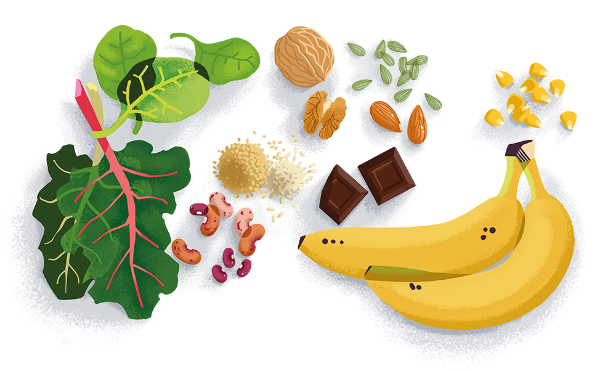Where we find magnesium
Magnesium is an essential element for human health, as well as one of the most commonly found minerals in the human body. It is estimated that the total quantity of magnesium in adults varies from 20 g to 28 g (around 0.34% of body mass!). Magnesium is distributed between:

When we talk of intracellular magnesium we refer to that found in the muscles, soft tissues and red blood cells; extracellular magnesium on the other hand also includes serum magnesium.
Unfortunately, as serum contains only 0.3% of the magnesium found in the human body, checking total reserves simply by analysing the serum may not be very accurate. To understand if a person suffers from hypomagnesemia (magnesium deficiency), we have to measure the magnesium dosage through a loading test on urine collected over 24h.
In most cases, however, disturbances caused by magnesium deficiency are easy to identify, making the diagnosis immediate even without specific clinical tests.
Magnesium in foods: the secret lies in what we eat
In normal conditions, the plasmatic concentration of magnesium varies between 1.7 and 2.6 mg/dL. To keep these values constant, the daily intake of magnesium is 420 mg for men and 320 mg for women, excluding periods of pregnancy and breast-feeding, when the intake should be between 350 and 450 mg.
A correct, balanced diet can provide the body with all the nutrients it requires. In the case of magnesium, water intake is also essential: alone, in fact, it can provide almost 10% of the daily requirement. The waters richest in magnesium are “hard waters”, those which contain around 30 mg/L of the mineral.
The foods that are richest in magnesium are walnuts, cocoa, oil seeds (e.g., pumpkin, sunflower, linseed and soy), beans, cereals and all green vegetables (in fact, magnesium is an integral part of chlorophyll!). To a lesser extent, good sources of magnesium are also fruit (particularly peaches, bananas and cherries), meat, fish and dairy products. However, take care when cooking, even for a short time, as this significantly reduces the content of magnesium, and generally all the most important nutrients.
Magnesium content in foods:
| HIGH | mg/100 g | MEDIUM | mg/100g | LOW | mg/100g |
|---|---|---|---|---|---|
| Bran | 420 | Sweetcorn | 120 | Pasta | 57 |
| Dark chocolate | 292 | Chard | 113 | Fish | 54 |
| Almonds | 255 | Milk chocolate | 107 | White flour | 37 |
| Cocoa | 192 | Whole grain rice | 106 | Bananas | 31 |
| Peanuts | 167 | Dried figs | 82 | Veal | 28 |
| Whole wheat bread | 60 | Beef, pork | 25 | ||
| Cherries | 14 | ||||
| Plums, oranges | 11 | ||||
| Apples, pears | 10 |
How many types of magnesium are there?
Magnesium is sold in different forms, and they are not all the same. The different types of magnesium are divided into:
- organic salts (magnesium pidolate, magnesium gluconate, magnesium citrate, magnesium aspartate)
- inorganic salts (magnesium oxide, magnesium chloride, magnesium sulphate, magnesium carbonate)
- magnesium complexes, or chelates (magnesium glycinate)
| MAGNESIUM SALT | GRAMS OF MAGNESIUM PER GRAM OF COMPOUND | PERCENTAGE OF MAGNESIUM BY COMPOUND |
|---|---|---|
| Magnesium oxide | 0,600g | 60% |
| Magnesium citrate | 0,160g | 16% |
| Magnesium lactate | 0,120g | 12% |
| Magnesium pyruvate | 0,100g | 10% |
| Magnesium sulphate | 0,100g | 10% |
| Magnesium pidolate | 0,087g | 8,7% |
| Magnesium orotate | 0,077g | 7,7% |
| Magnesium gluconate | 0,058g | 5,8% |
Organic forms are more absorbable than inorganic forms, and this is why most magnesium supplements are made with organic salts. However, among the various salts available, magnesium oxide is that with the highest content of magnesium element, and is therefore an excellent source when made more absorbable. This is the task of Sucrosomial® Technology, a patented delivery system that encapsulates the magnesium oxide molecules in a protective matrix that increases gastroresistance and improves absorption.
